Just 12 years ago Yamaha dropped a bomb on the motocross world: Not only would the company release a four-stroke motocrosser to the public, it would laugh at what was considered to be four-stroke doctrine at the time. For those of you too young to remember, four-stroke motocross machinery at the time-when there was any-came from Europe or was handmade by specialty shops, and the rules allowed four-strokes up to 550cc to race in the 250cc class against two-strokes. Yamaha opted for a five-valve 400, and the public couldn't imagine how a four-stroke that small could compete. Yamaha proved everyone wrong, and the company appears ready to attempt a similar lesson in 2010.Without reinventing internal combustion, the '10 couldn't be a more radical departure from existing Yamaha motocross technology and practice. The wheels and one brake are the only carryovers from the existing YZ line. All other parts of the 2010 YZ450F are new and redesigned. As it did with the original YZ400F, Yamaha chose not to bow to convention. The 2010 chassis and engine were designed together for what Yamaha calls an "ideal rigidity balance." This chassis is made up of cast, forged and extruded parts for a total of 16 components formed into what Yamaha has termed a "double S-beam" design. To us mortals it means that the side spars have S-curves when looking at them from the side and also when looking down from the top. The open spars at the top of the frame look narrower near the steering head than examples from other brands.The body parts and engine look more exotic since the air intake and airbox are at the front of the frame with the filter unit being under the fuel tank in a direct line below the gas cap. Yamaha leaned the top end of the engine back slightly, and the tunable 44mm Keihin throttle body fuel injection gets a straight shot to the now four-valve cylinder head. Yamaha claims that with FI, two intake valves worked better than the three it has used for 12 years.Yamaha did much more than lean the cylinder and head back; the engine is all-new with a shorter stroke, larger bore and the crank set deeper in the engine cases so the portion of the cylinder that shows looks like it is 20 percent shorter than the 2009 cylinder. In addition to being set deeper, the crank is offset to the rear of the cylinder. This is common in street engines, and it both saves on friction loss and minimizes side loading on the piston against the cylinder wall.With the induction in the front, that means the exhaust pipe must exit to the rear, and what a pipe it is. To gain tuned length, what Yamaha calls a "tornado style" pipe makes a twisting loop in the center of the frame. With no conventional airbox to deal with, the shock is angled forward and centered in the frame. As you can imagine, adjusting shock spring preload is a snap. Additionally, fuel is carried closer to the center of the chassis.We haven't ridden the bike, but the ergonomics should be much like the YZ250F, which we have ridden, and the bike should be very easy for the rider to move around on front-to-back. For sure the YZ450F will have more visual "Wow!" than any bike at the track. We can't wait to see if it feels as good as it looks.
Latest
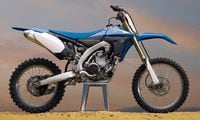
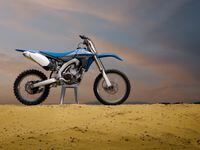
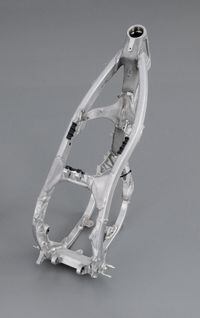
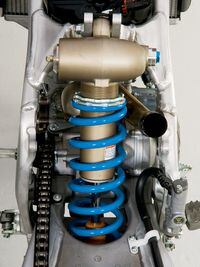
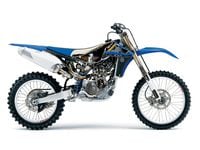
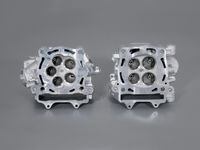
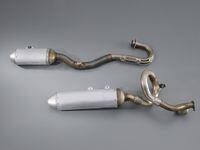
/cloudfront-us-east-1.images.arcpublishing.com/octane/YKVV7MAMARETDN3DBACJEEA7WI.jpg)
/cloudfront-us-east-1.images.arcpublishing.com/octane/EMYFSSH6N5CZZLDVVTM5M3QPWI.jpg)
/cloudfront-us-east-1.images.arcpublishing.com/octane/F4FOUTYVDBEIZIPVNBRDE4DI5A.jpg)
/cloudfront-us-east-1.images.arcpublishing.com/octane/OO3SHIQWLNCSNIKKXSB3YKVR6I.jpg)
/cloudfront-us-east-1.images.arcpublishing.com/octane/2KNSO5QWYVES7NNWEUVMPBGAKE.jpg)
/cloudfront-us-east-1.images.arcpublishing.com/octane/EIDNKNRSYRBBHFBWU42T2CNLUY.jpg)
/cloudfront-us-east-1.images.arcpublishing.com/octane/RWOOGRUMOJHAFDL5FBYOWC4TD4.jpg)
/cloudfront-us-east-1.images.arcpublishing.com/octane/ZK4K2SDU4VH6PL3ELKBGVPLPMA.jpg)
/cloudfront-us-east-1.images.arcpublishing.com/octane/3NTHRLVK6NH7XCT2YTFXSSBMXQ.jpg)
/cloudfront-us-east-1.images.arcpublishing.com/octane/FOUCESDTU5AAJG7S6GCDUQCG3I.jpg)
/cloudfront-us-east-1.images.arcpublishing.com/octane/NDW4FJMPRBHSNPXBBR6E7NMGDE.jpg)
/cloudfront-us-east-1.images.arcpublishing.com/octane/NJHEQAXWPFHW5AIDGXU3CKIL7Y.jpg)
/cloudfront-us-east-1.images.arcpublishing.com/octane/LSZ24J4AHVCEFKXJZI2IIXZKQE.jpg)
/cloudfront-us-east-1.images.arcpublishing.com/octane/B53RRBFX2NCMXGOYSKIRXRZLDM.jpg)
/cloudfront-us-east-1.images.arcpublishing.com/octane/LZO6GGGGJRDIBOSTOTWUYQMO4E.jpg)
/cloudfront-us-east-1.images.arcpublishing.com/octane/B2RVKZ3C5JBMLNEMJNQZC6PLJM.jpg)
/cloudfront-us-east-1.images.arcpublishing.com/octane/QNSTOTKFCRHZVJVLOAY5A35IXQ.jpg)
/cloudfront-us-east-1.images.arcpublishing.com/octane/GOYME2C6MVHL7COKUQXWB3736A.jpg)
/cloudfront-us-east-1.images.arcpublishing.com/octane/4FYZ6WICRFAS3KKWBPVHVLCCUM.jpg)
/cloudfront-us-east-1.images.arcpublishing.com/octane/VPPCRIZHKJHEJHIOYVFEIHIB3U.jpg)
/cloudfront-us-east-1.images.arcpublishing.com/octane/IXQTHHA3L5H3BH3WFUNNF33VEQ.jpg)
/cloudfront-us-east-1.images.arcpublishing.com/octane/RUNRR6IYQVA43JDR55ZMAOA7XA.jpg)
/cloudfront-us-east-1.images.arcpublishing.com/octane/SMVUQAKWYJHWDDTQTIUQQJO34Y.jpg)
/cloudfront-us-east-1.images.arcpublishing.com/octane/OWMGVFWC5ZF3RJ2XRWSIDF2NRI.jpg)